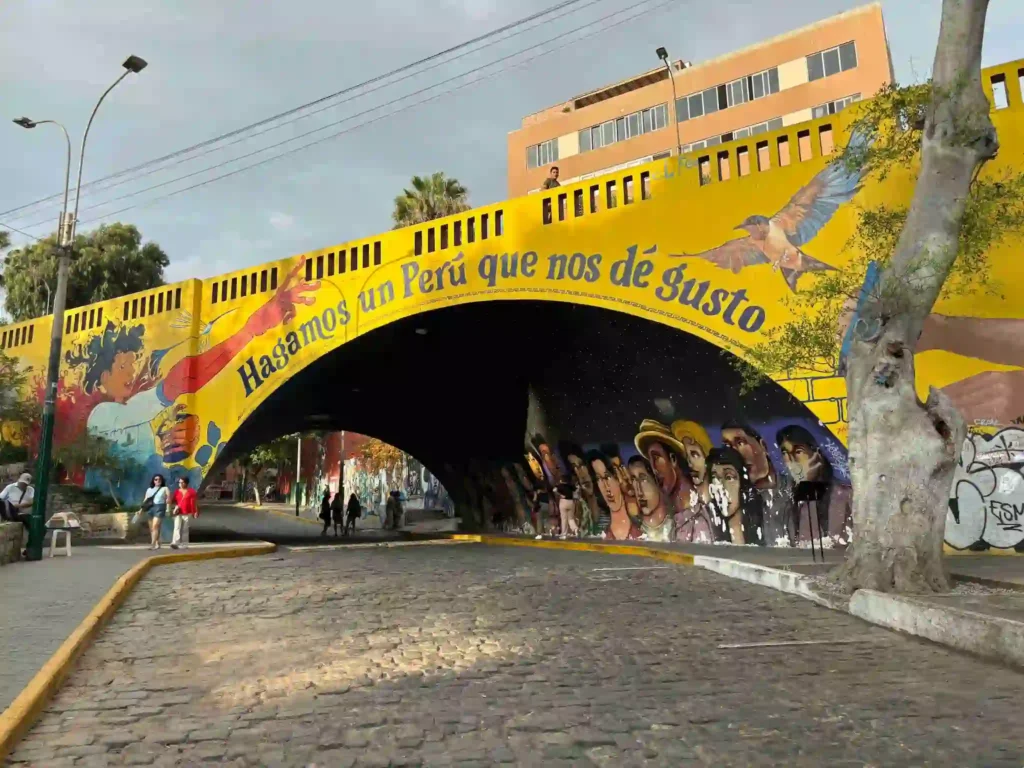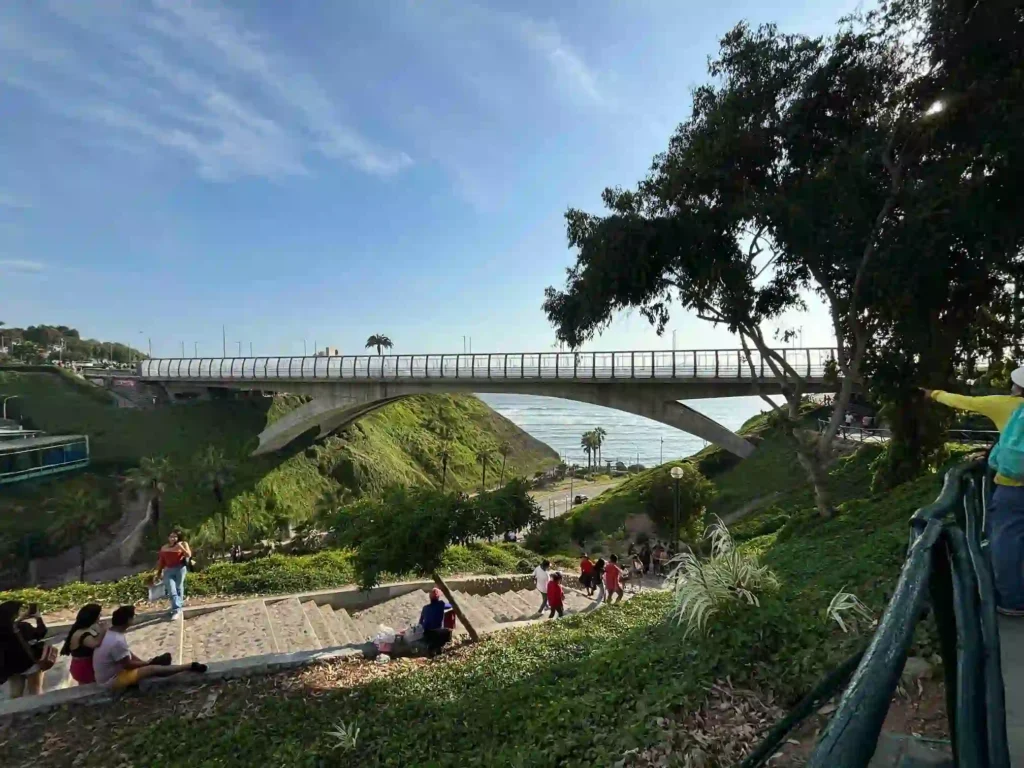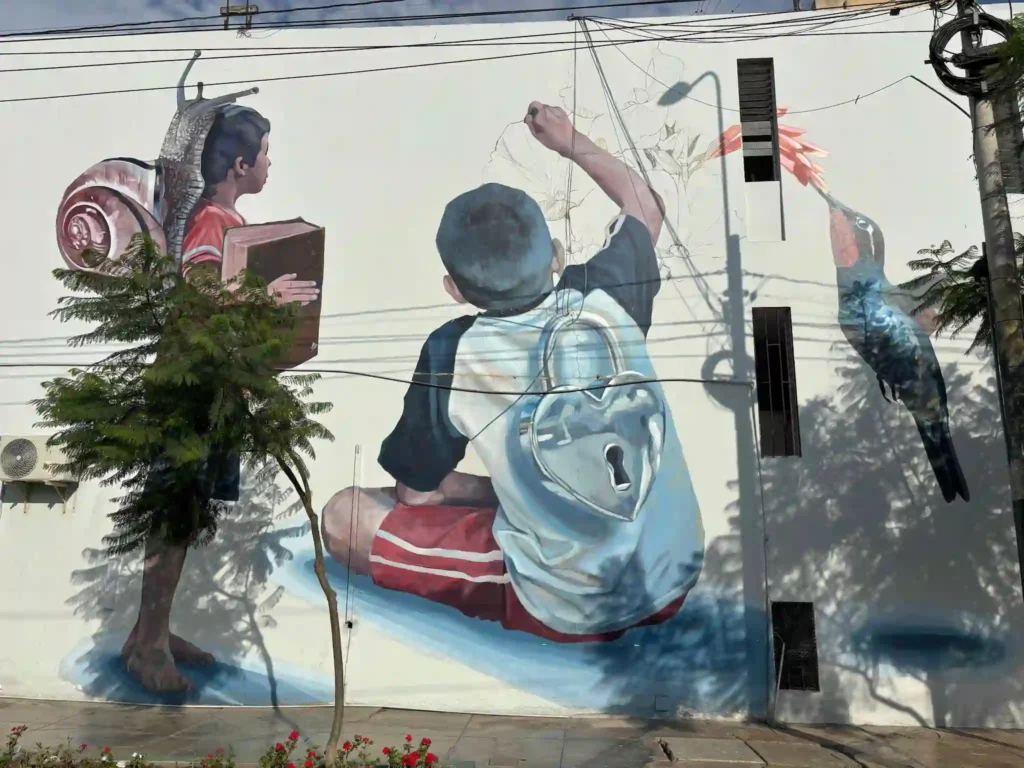I spent four days in Lima, after everyone had told me not to waste time there, simply because I needed a little time to sit and plan what I was going to do next! Looking back, I’m so glad I ignored their advice because there are plenty of incredible things to do in Lima, Peru that made my stay worthwhile. My favourite thing here was the street art in Barranco and the INCREDIBLE sunsets over the Pacific Ocean that paint the sky in unbelievable colours each evening.
Lima has two main selling points that draw people into the city (other than being the capital of Peru, of course): firstly, because it has an incredible surf scene, with impressive waves coming in from the Pacific Ocean, and secondly because it is the food capital of Latin America. This includes the famous restaurant Central, which was voted the best restaurant in the world in 2023.
The two main places to stay in Lima for tourists are Barranco and Miraflores. I liked the vibe around Barranco with its bohemian atmosphere, but it was a bit chaotic, and it may have been nicer to stay in Miraflores in hindsight.
*this article contains some affiliate links

About Lima
Lima is Peru’s sprawling capital city, home to around 10 million people, which is about a third of the country’s entire population. Founded in 1535 by Spanish conquistador Francisco Pizarro, the city has a rich history that spans nearly five centuries. Once the most important city in South America during the Spanish colonial period, Lima’s historic centre is now a UNESCO World Heritage site, filled with stunning colonial architecture and vibrant plazas.
Most travellers need at least 2-3 days to experience the highlights of Lima, though many rush through in just a day or two on their way to Machu Picchu or other Peruvian destinations (and, to be fair, there are loads of other cool things to see in Peru, so from this angle I understand why people say you should skip through Lima). Lima is a major destination in its own right with world-class museums, incredible food, and distinct neighbourhoods each with their own character.
🇵🇪 Read more: A Travel Guide to Lima Peru
How to Get to Lima
Lima is usually your first or last stop in Peru, as it’s the country’s capital and has a very well-serviced international airport. Jorge Chávez International Airport connects Lima to many places all over Latin America and even further afield around the world, with direct flights from major cities in North America, Europe, and across South America.
If you’re already in Peru, you can fly to Lima from Cusco in about 1.5 hours (typically costing between S/150-400 (€35-95) depending on the season and how far in advance you book). You can also take the bus along the classic Peruvian tourist trail from Cusco to Lima, but I’d recommend spending a week or more stopping along the way if you choose this route, partly because it’s a mighty long way and partly because it’s worth it.
Things to Do in Lima Peru
There are so many things to do in Lima Peru that you could easily spend a week here without getting bored. From incredible museums to stunning coastal views, vibrant neighbourhoods to world-class dining, Lima offers something for every type of traveller.
Explore Barranco’s Street Art
The Barranco district street art tour was one of my favourite free walking tours I did in Latin America (free walking tours are generally quite a big thing in Europe and Latin America, but not so much in Asia or Africa). They take you around all of the street art that Barranco is famous for and tell you about the history behind it. The district has become a hub for Peruvian artists, with colourful murals covering many walls and buildings.
The tour starts in the main plaza in Barranco and takes you to the Bridge of Sighs (Puente de los Suspiros), a romantic wooden bridge with a lovely legend, and winds through Barranco’s most picturesque streets. You’ll discover artwork by both local and international artists while learning about the neighbourhood’s transformation from a seaside resort for Lima’s elite to its current status as the city’s bohemian, artistic heart.
While the tour is technically free, remember to tip your guide what you think the experience was worth (typically S/25-40 (€6-10) is appropriate).
🇵🇪 Read more: Where to Stay in Lima Peru

Take a Miraflores Walking Tour
The walking tour we did in Miraflores wasn’t really for me because I really didn’t like the guide that we had, but of course getting a bad guide is quite rare and I met a lot of people who’d really enjoyed their tour of Miraflores. This upscale district is known for its shopping centres, beautiful parks, and stunning ocean views. It’s also the place where most hotels and hostels are, making it the most popular district for tourists.
A typical Miraflores tour includes a visit to Kennedy Park (a good place to see local cats that are cared for by the community), Parque del Amor (Love Park), where you’ll see the famous kissing statue and mosaic walls, and the Larcomar shopping centre built into the cliffs overlooking the Pacific Ocean. You’ll also often walk along the malecón (okay, well, not the whole thing), a six-mile stretch of parks and gardens along the cliffside with spectacular ocean views.
Visit the Historic Centre of Lima
The historic centre of Lima holds the heart of the city’s colonial past and is a great place to soak in Peruvian history. The main square, Plaza Mayor (also called Plaza de Armas), is surrounded by important buildings including the Government Palace, the Cathedral of Lima, and the Municipal Palace.
Just a short walk away is Plaza San Martín, another beautiful square surrounded by historic buildings. The historic centre is packed with museums, churches, and colonial mansions that give you a glimpse into Lima’s past. Taking a guided tour here is a great way to understand the city’s history and significance.
EAT Your Way Through the Food Capital of Latin America
Lima is considered the gastronomic capital of Latin America, and eating your way through the city is one of the best things to do in Lima, Peru. The city offers everything from street food to high-end restaurants that regularly appear on the world’s best restaurants lists.
Try Traditional Peruvian Cuisine
Don’t leave Lima without trying these Peruvian specialties:
- Ceviche: Fresh raw fish marinated in lime juice with onions, chili, and sweet potato. La Mar in Miraflores is one of the best places to try this national dish.
- Lomo Saltado: A stir-fry that combines marinated strips of beef with onions, tomatoes, and French fries.
- Guinea Pig (Cuy): A traditional Andean dish that might not be for everyone, but is worth trying if you’re adventurous.
- Llama: Another traditional meat from the Andes, often served as steaks or in stews.
- Pisco Sour: Peru’s national cocktail made with pisco (grape brandy), lime juice, egg whites, and bitters.
➡️ The best way to explore? Take a food tour in Lima
Dine at Central Restaurante
If you’re a food enthusiast with some room in your budget, consider booking a table at Central, voted the best restaurant in the world in 2023. Chef Virgilio Martínez’s innovative tasting menu walks you through Peru’s diverse ecosystems, from the Pacific Ocean to the high Andes. Reservations need to be made months in advance, and a meal here starts at around S/1,000 (€240) per person – but for food lovers, it’s a once-in-a-lifetime experience.
Visit Some of Peru’s Best Museums
Lima is home to some excellent museums that showcase Peru’s rich history:
Larco Museum (Museo Larco): Housed in an 18th-century mansion, this museum has an impressive collection of pre-Columbian art, including a famous gallery of erotic pottery.
Museum of Art of Lima (MALI): Located in the beautiful Exposition Palace, MALI features Peruvian art from pre-Columbian times to today.
MATE Museum: Founded by renowned fashion photographer Mario Testino, this museum showcases both his work and changing contemporary art exhibitions.
Explore Ancient Ruins in the City
Remarkably, Lima has several archaeological sites right in the middle of the city:
Huaca Pucllana: This impressive adobe pyramid in Miraflores dates back to 400 CE and was built by the Lima Culture. You can take a guided tour of the ruins and even dine at the on-site restaurant that overlooks the illuminated ruins in the evening.
Huaca Huallamarca: Another pre-Inca adobe pyramid located in the San Isidro district.
Watch the Magic Water Circuit
The Magic Water Circuit (Circuito Mágico del Agua) in Parque de la Reserva is a fantastic evening activity. This park features 13 different illuminated fountains, including one that shoots water 80 meters into the air. The highlight is a water fountain show set to music and lights – it sounds a bit cheesy, but it’s actually really impressive and a popular thing to do for both tourists and locals.

Day Trips from Lima
If you have extra time and you’re not planning to travel further south in Peru, consider these day trips:
- Huacachina: An incredible desert oasis about 4 hours from Lima where you can sandboard and ride dune buggies.
- Paracas and the Ballestas Islands: Often called the “Poor Man’s Galapagos,” these islands are home to sea lions, penguins, and many bird species.
- Palomino Islands: Closer to Lima, these islands offer the unique opportunity to swim with sea lions.
Practical Tips for Visiting Lima
Getting Around Lima
Getting around Lima requires a bit of planning due to the city’s size and traffic conditions.
Walking is perfectly feasible within Barranco or within Miraflores, but otherwise, you’ll probably want to take transport. The districts are relatively flat and pleasant to explore on foot, with plenty to see along the way.
For public transport, you can take the Metropolitano bus system between Barranco and Miraflores (I wouldn’t recommend venturing outside of these areas without a tour guide on public transport or any other way for that matter). While it’s cheap (about S/2.50 (€0.60) per ride), it can be really crowded during rush hour.
When it comes to taxis, only use Uber or a taxi booked with your accommodation. Any other taxis are dodgy and are likely to rip you off, especially at the airport! Lima taxi drivers are notorious for overcharging tourists, so having a set price through an app or your hotel is much safer.
You can book a transfer to pick you up from Lima Airport for a fair price (around S/70 (€17)), which is worth it for the peace of mind after a long flight. In Lima, I booked my transfer through my hostel, but I’ve used Welcome Pickups a bunch of times and always recommend them for reasonably priced transfers. (Or, read this article on other ways to get from Lima Airport to Miraflores).
Bicycle rental is available in Miraflores and along the malecón, which has dedicated bike lanes. Prices typically start at around S/30 (€7) for a few hours.
Best Time to Visit Lima
Lima has a unique climate due to its location on the Pacific coast. They rarely sees rain, but from May to November, Lima is often covered in a grey mist called “garúa.”
The best time to visit Lima is during the summer months from December to April, when the skies are clearer and temperatures average between 20-28°C. This is when you’ll have the best chance of seeing those incredible sunsets I mentioned.
May through November is Peru’s winter, with temperatures between 15-19°C. While the temperature is still mild, the persistent grey fog can make the city feel a bit gloomy. However, this is the off-peak tourist season, so in exchange you’ll find fewer crowds and lower prices.
If you can, try to time your visit during Mistura (usually in September), Latin America’s largest food festival, or Fiestas Patrias (July 28-29), Peru’s independence celebrations with parades and festivities.
Money & Costs in Lima
Lima is relatively affordable compared to European or North American cities, but it’s one of the more expensive Peruvian cities. You can adjust your spending based on your travel style:
- Budget travellers can get by on S/120-200 (€29-48) per day, staying in hostels (S/40-60 (€10-15) for a dorm room), eating at local markets, and using public transportation.
- Mid-range travellers should budget S/250-400 (€60-96) per day for nicer hotels, restaurant meals, and some activities.
- Luxury travellers can expect to spend S/500+ (€120+) per day for high-end hotels, fine dining, and private tours.
ATMs are widely available in tourist areas. Interbank and BCP often have lower fees than other banks. Most hostels, restaurants, and shops in tourist areas accept credit cards, but sometimes with an additional fee of 5-7%. It’s always good to carry some cash for smaller purchases and in case of technical issues.

FAQs About Lima
Is Lima safe for tourists?
Lima is generally safe in the main tourist areas of Miraflores, Barranco, and San Isidro, especially during the day. However, like any major city, it has areas that are best avoided. Stay vigilant about your belongings, especially in crowded places, and avoid walking alone late at night. Using registered taxis or ride-sharing apps rather than hailing cabs off the street is strongly recommended.
How many days do I need in Lima?
I’d recommend at least 2-3 days to experience the highlights of Lima without feeling rushed. If you’re a food enthusiast or interested in museums, consider adding an extra day or two.
Is Lima worth visiting if I’m mainly going to Peru for Machu Picchu?
Absolutely! While Machu Picchu is undoubtedly incredible, Lima offers a different but equally valuable perspective on Peruvian culture. The city’s food scene alone is worth the visit, and its museums provide useful context for the archaeological sites you’ll see later. Even a day or two in Lima will enhance your overall understanding and appreciation of Peru.
What’s the best neighbourhood to stay in Lima?
For first-time visitors, Miraflores is usually the best choice. It’s relatively safe, central, has lots of amenities, and offers easy access to the coast. Barranco is a good alternative if you prefer a more bohemian, artistic atmosphere with great nightlife, while San Isidro has the most upscale hotels and restaurants.
Can I drink tap water in Lima?
No, it’s not advisable to drink tap water in Lima. Stick to bottled water, which is readily available everywhere. Unlike in Central America, it’s not common for hotels and hostels to provide free drinking water, although it doesn’t cost much to buy it at the local shop or supermarket.
Conclusion
Lima is so much more than just a jumping-off point for other Peruvian adventures. With its rich history, incredible food scene, vibrant neighbourhoods, and beautiful coastal setting, Peru’s capital deserves to be appreciated as a destination in its own right. The things to do in Lima Peru range from exploring ancient ruins and world-class museums to sampling the best food in Latin America and watching breathtaking Pacific sunsets.
Whether you’re spending just a couple of days in the city or making it a longer stay, Lima offers a perfect introduction to the wonders of Peru. So the next time someone tells you to skip Lima, do what I did – ignore them and discover this fascinating city for yourself!
